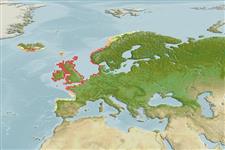Common names from other countries
Classification / Names / Names
Nombres comunes | Sinónimos | Catalog of Fishes (gen., sp.) | ITIS | CoL | WoRMS
Environment: milieu / climate zone / depth range / distribution range
Ecología
; salobre; rango de profundidad 7 - 9 m (Ref. 2851). Temperate
Distribución
Países | Áreas FAO | Ecosistemas | Ocurrencias, apariciones | Introducciones
Northeast Atlantic: Europe.
Length at first maturity / Tamaño / Peso / Age
Maturity: Lm ? range ? - ? cmedad máxima reportada: 1.00 años (Ref. 130103)
Depth based on occurrence (Ref. 2851, p. 719); to be replaced with better reference. Life span is less than 1 yr (Ref. 130103). Found in estuarine and inshore areas in silt to very fine sand substrate. A microvore that feeds on organic detritus (Ref. 96352).
Life cycle and mating behavior
Madurez | Reproducción | Puesta | Huevos | Fecundidad | Larva
Members of the order Cumacea are gonochoric and sexually dimorphic. Spawning is characterized by nocturnal swarming behavior. Females brood the eggs in the marsupium where they molt, become mancas and leave.
Alves, F., L. Chicharo, A. Nogueira and J. Regala. 2003. (Ref. 2851)
IUCN Red List Status (Ref. 130435)
CITES status (Ref. 108899)
Not Evaluated
Not Evaluated
Human uses
| FishSource |
Herramientas
Más información
Age/SizeCrecimientoLength-weightLength-lengthMorfologíaLarvaAbundancia
Fuentes de Internet
Estimates based on models
Preferred temperature
(Ref.
115969): 8.9 - 12.5, mean 10.7 (based on 314 cells).
Resiliencia
Alto, población duplicada en un tiempo mínimo inferior a 15 meses (tmax<1).
Price category
Unknown.
